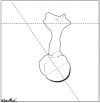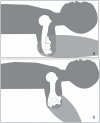The Development of Humeral Retrotorsion and Its Relationship to Throwing Sports
- PMID: 26502441
- PMCID: PMC4622383
- DOI: 10.1177/1941738115608830
The Development of Humeral Retrotorsion and Its Relationship to Throwing Sports
Abstract
Context: Several investigations have noted that throwing athletes exhibit a more posteriorly oriented humeral head (humeral retrotorsion) in the dominant arm. This asymmetry is believed to represent an adaptive response to the stress of throwing that occurs during childhood. The significance of this alteration and factors that affect its development are currently not clear.
Evidence acquisition: Basic science, research studies, and review articles were searched through PubMed with search terms including humeral torsion, humeral retrotorsion, and with 1 of the following: pediatric, adult, baseball, pitching, shoulder, and range of motion. The references from each article were reviewed for further inclusion. This review included articles through March 2015.
Study design: Clinical review.
Level of evidence: Level 4.
Results: The throwing motion creates stressors that result in bony adaptations that occur while skeletally immature. These osseous changes likely contribute to the observed shift in the arc of rotational range of motion noted in throwing athletes and may play a protective role against injury. However, too much or too little retrotorsion may predispose the shoulder to injury. The degree of "optimal" humeral retrotorsion and factors that influence its development are not fully understood.
Conclusion: Evidence supports the assertion that the throwing motion creates stressors that alter bony anatomy while young. It is important to determine what specific factors affect this adaptation and its relationship to injury.
Keywords: humeral retrotorsion; humeral torsion; pediatric; shoulder range of motion; throwing athlete.
© 2015 The Author(s).
Conflict of interest statement
The following authors declared potential conflicts of interest: Elliot M. Greenberg, PT, DPT, OCS, CSCS, receives payment for lectures, including service on speakers bureaus for the Professional Therapy Seminars Pediatric Sports Rehabilitation Course; J. Todd R. Lawrence, MD, PhD, received royalties from Sawbones Inc.; Philip McClure, PT, PhD, FAPTA, has grants/grants pending from the NIH and receives payment for lectures, including service on speakers bureaus for Rehab Education. A portion of this article was supported by the Legacy Fund Grand through the Sports Section of the APTA.
Figures






References
-
- Anz AW, Bushnell BD, Griffin LP, Noonan TJ, Torry MR, Hawkins RJ. Correlation of torque and elbow injury in professional baseball pitchers. Am J Sports Med. 2010;38:1368-1374. - PubMed
-
- Bailey AJ, Paul RG, Knott L. Mechanisms of maturation and ageing of collagen. Mech Ageing Dev. 1998;106:1-56. - PubMed
-
- Bailey LB, Beattie PF, Shanley E, Seitz AL, Thigpen CA. Current rehabilitation applications for shoulder ultrasound Imaging. J Orthop Sports Phys Ther. 2015;45:394-405. - PubMed
-
- Bigliani LU, Codd TP, Connor PM, Levine WN, Littlefield MA, Hershon SJ. Shoulder motion and laxity in the professional baseball player. Am J Sports Med. 1997;25:609-613. - PubMed
-
- Burkhart SS, Morgan CD, Kibler WB. The disabled throwing shoulder: spectrum of pathology. Part I: pathoanatomy and biomechanics. Arthroscopy. 2003;19:404-420. - PubMed
Publication types
MeSH terms
LinkOut - more resources
Full Text Sources
Other Literature Sources
Research Materials

